Seakeeper 2 Installation Manual (90488-4); S/N 2-232-1564 to Current
2.3 Bolt-In Installation
2.3.1 Preparation of Boat Structure
The Seakeeper Drawing No. 90590, Seakeeper 2 Generic Installation Guide shows various structural arrangements to support the installation of the Seakeeper. The Generic Installation Guide offers above and below deck installation arrangements with fiber-reinforced plastic (FRP) and aluminum structures, which should provide solutions for most vessels. The Seakeeper 2 is affixed to the hull structure via four bolts in the
Seakeeper 2 frame. Depending on the structure to which the Seakeeper is fastened, blind threaded holes or through-bolting can be utilized.
Refer to Seakeeper Drawing No. 90487, Seakeeper 2 Bolt in Installation Details. Important dimensional and load information is given in this drawing that will impact the design details of the structure that will receive the Seakeeper. It is assumed that a proper structural analysis has been performed for the hull structure to which the Seakeeper will be fastened to ensure proper strength margins for the loads the Seakeeper will create during operation.
The hull structure supporting the Seakeeper should be installed so the Seakeeper is parallel to the waterline in the transverse direction and within 1 degree longitudinally.
In addition, the four areas on top of the structure on which the Seakeeper 2 frame and isolation gaskets will rest, need to be co-planar within .06 in. (1.5 mm) to minimize potential distortion of Seakeeper support frame when installed. The isolation gaskets are only used when the Seakeeper 2 is mounted to a dissimilar metal structure.
Seakeeper offers an optional installation template kit, P/N 90473, which contains four plates that mimic the mating surfaces of the four feet located on the Seakeeper ’s foundation. These plates have 4 holes located at the same centers as the mounting holes on the Seakeeper 3.The fixture locates the hole patterns at the proper spacing both in the forward-aft direction and the port-starboard direction. See Figure 4 below. Once assembled, the fixture can be used to check clearances and alignment of the hull structure.
Note: Do NOT use the installation fixture to establish the Seakeeper envelope dimensions. Refer to Drawing No. 90487 – Seakeeper 2 Bolt-In Installation Details, for envelope dimensions. A 3-D model of the Seakeeper is available on the Seakeeper Dealer Access website (www.seakeeper.com) to aid in designing the Seakeeper foundation and the space around the Seakeeper
NOTE: MAKE SURE NO OBSTRUCTIONS FROM THE HULL STRUCTURE CAN BE SEEN WITHINTHE INSIDE OF THE INSTALLATION TEMPLATE KIT (INSIDE THE MARKED RED LINES) AS SEEN IN FIGURE 5. REFERENCE SEAKEEPER DRAWING NO. 90487 – SEAKEEPER 2 BOLT-ININSTALLATION DETAILS
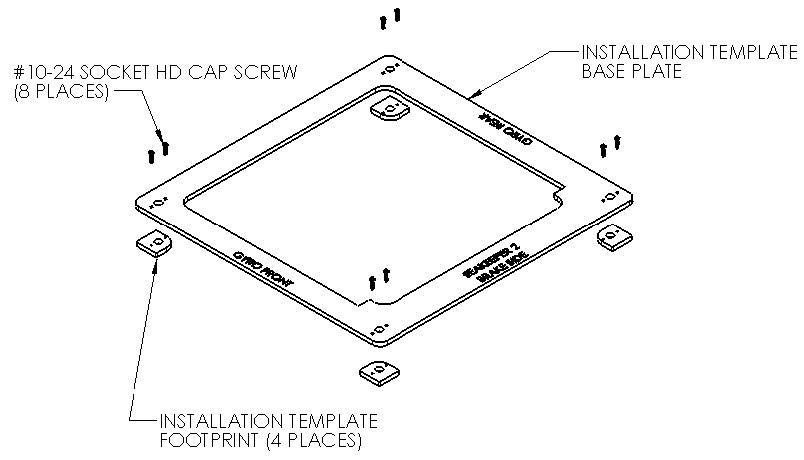
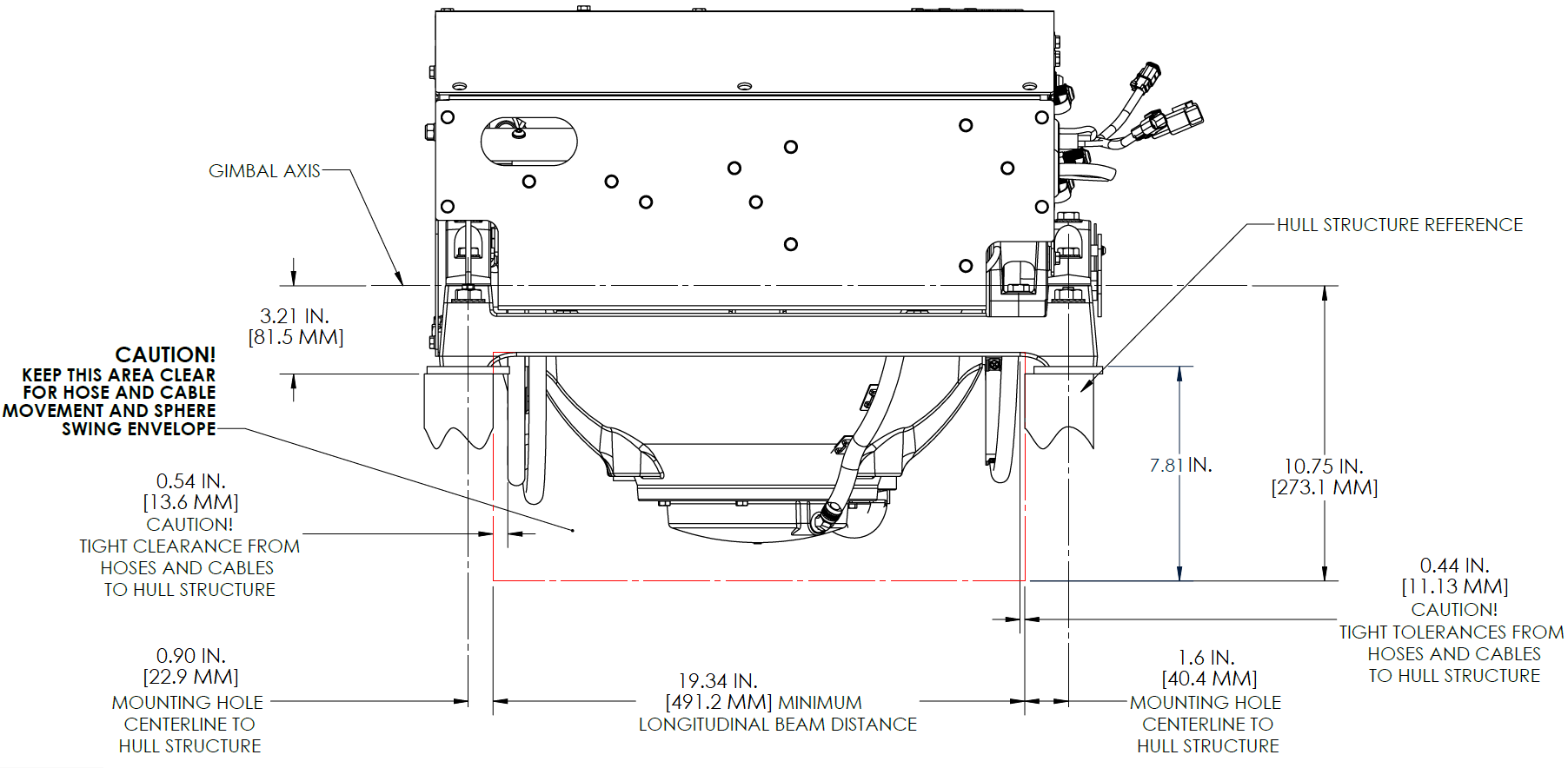
CAUTION: Tight clearances from cable guide bands to hull structure. See above Figure 5 for dimensions and reference Seakeeper Drawing No. 90487 – Seakeeper 2 Bolt-In Installation Details, for complete Seakeeper 2 envelope.
2.3.2 Transfer of Holes to Boat Structure
- Lower assembled fixture onto hull structure.
- The four areas where the feet of the Seakeeper will rest should be coplanar to within .06 in. (1.5 mm). See Figure 6.
- Align fixture in desired location and transfer holes from fixture plate to the hull structure using provided transfer punch. Note that holes in fixture plate are ø0.60 in. (15.138 mm).
- Remove fixture and drill and tap M14X2.0 Helicoil threaded insert holes in hull structure at marked locations to mate with holes in the Seakeeper foundation. Take special care to drill perpendicular to mounting surface. A drill guide is recommended. Remove any impeding obstructions.
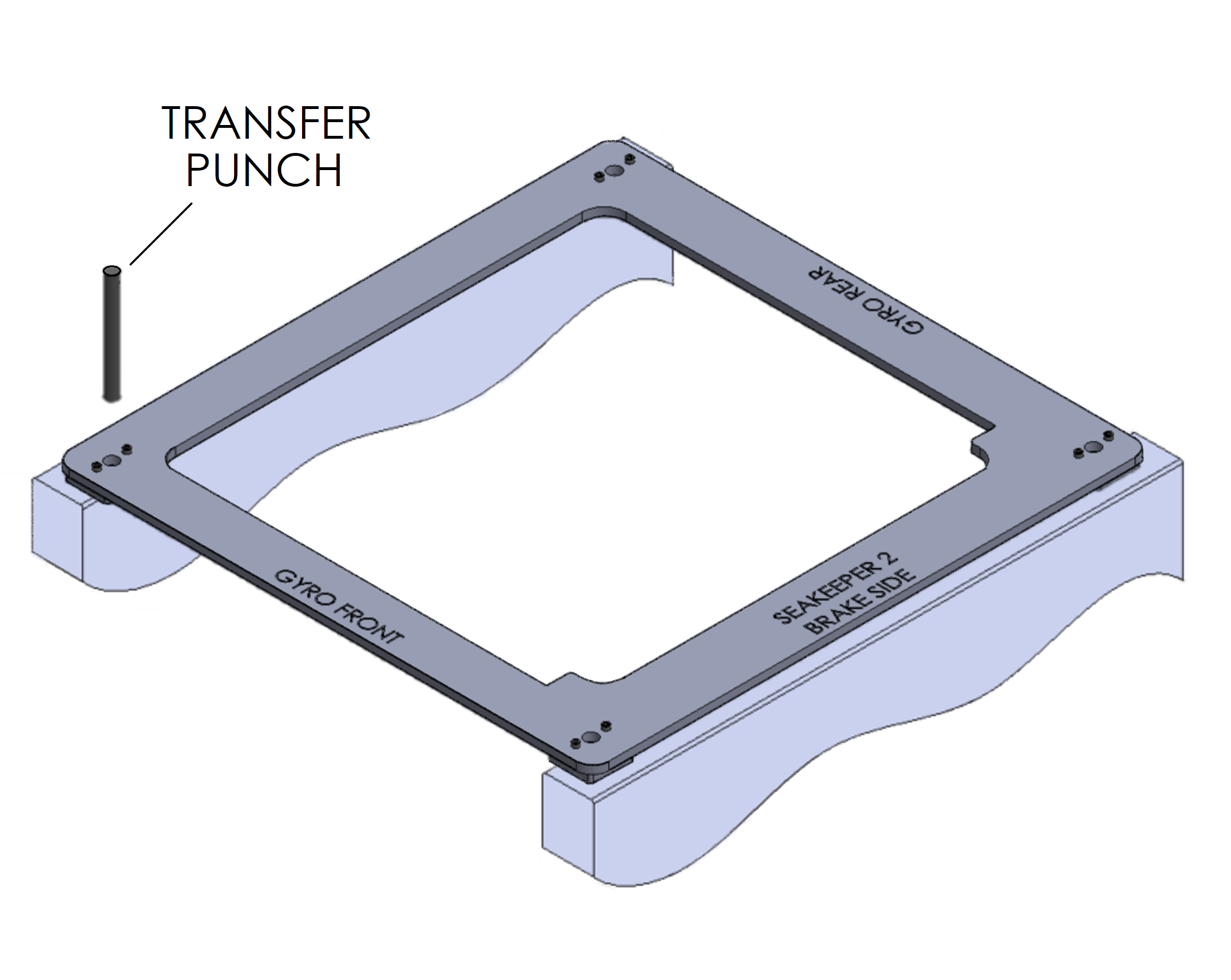
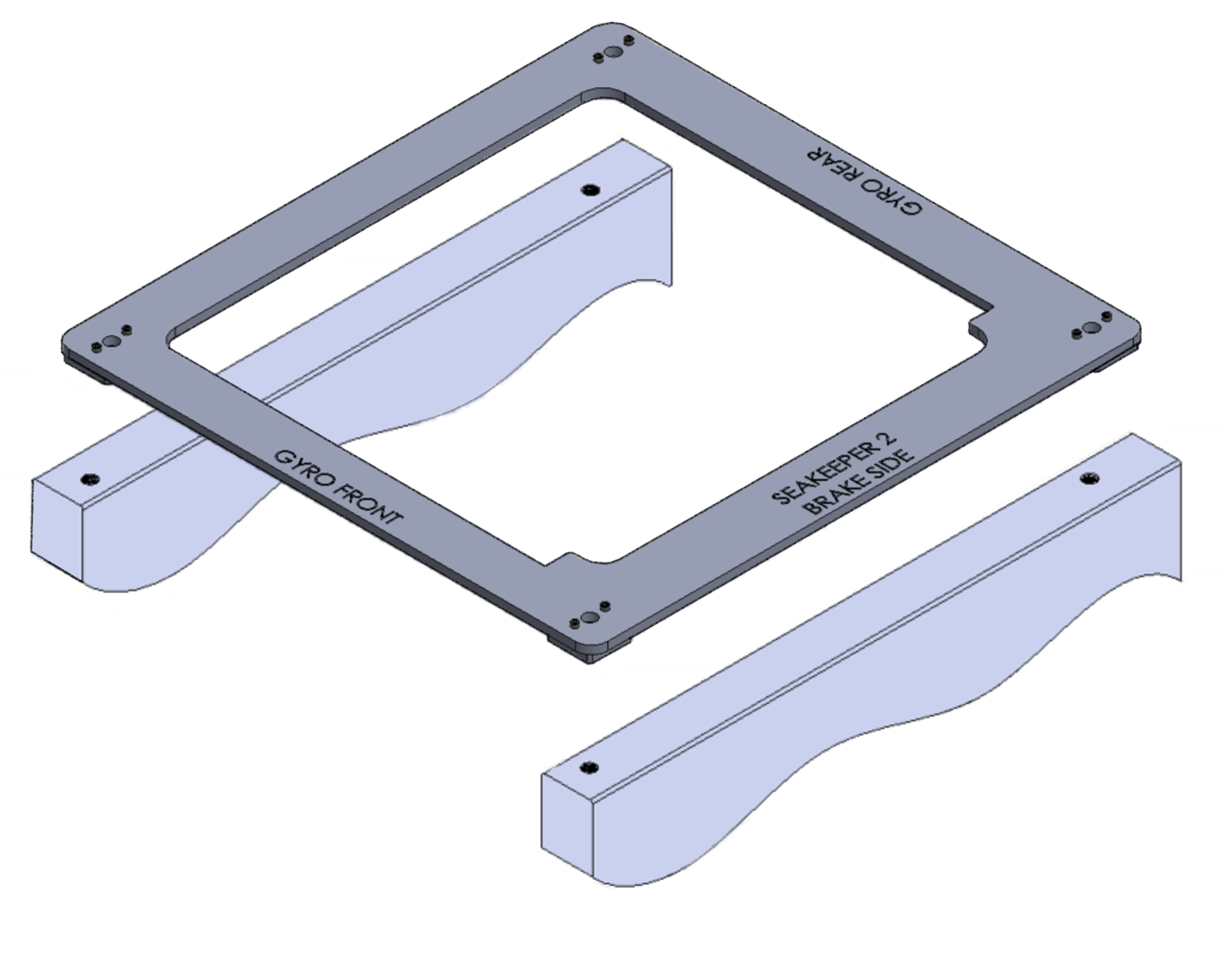
2.3.3 Installation of Seakeeper
- Lower Seakeeper into position onto the hull foundation beams and align over drilled holes. Apply a small bead of marine sealant (e.g., SILI-THANE 803 or equivalent)between mating surfaces of Seakeeper frame and hull structure to prevent moisture wicking into bolt holes.
- For dissimilar metal foundations locate and position 4 isolation gaskets onto foundation beams and apply a small bead of marine sealant (e.g., SILI-THANE 803or equivalent) between both mating surfaces of each isolation gasket where it contacts the beam and the Seakeeper (See Figure 7).
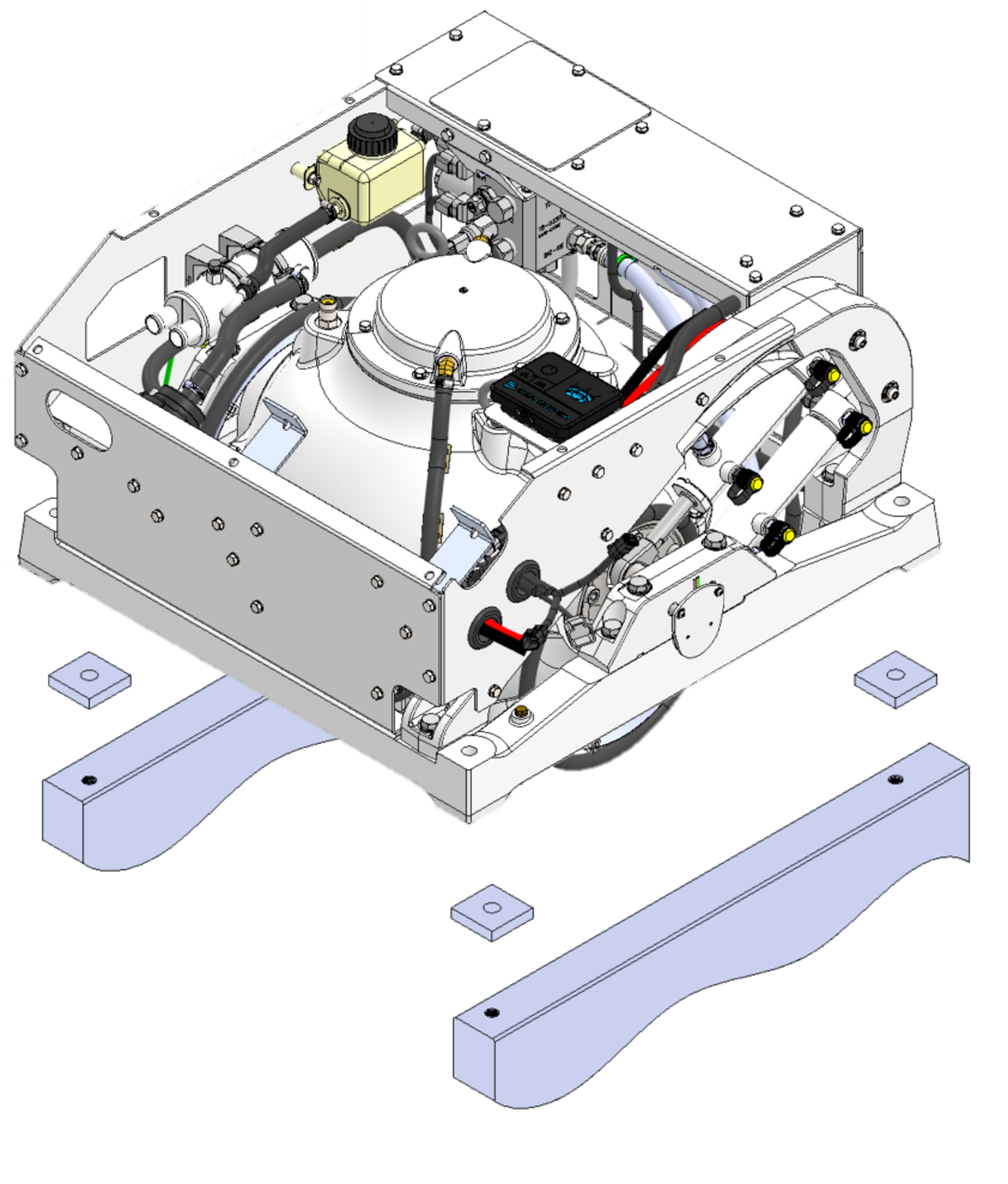
- Install mounting bolts:
- For Blind Hole Installations, install the Seakeeper supplied Grade 10.9, M14-2.0 x90 mm fasteners or alternative Grade 10.9, M14-2.0 bolts to maintain a minimum thread engagement of 0.83 in (21 mm). If Seakeeper supplied bolts do not achieve the minimum thread engagement because of the lamination thickness or structure, longer bolts of the same specification (M14-2.0, Grade10.9) should be sourced. If tapping directly into a metal frame shorter bolts maybe required. Apply a moderate coat of marine anti-seize (e.g., SAF-T-EZE nickel grade anti-seize, SBT-4N or equivalent) to the threads of each bolt and include a small bead of marine grade sealant (e.g., SILI-THANE 803 or equivalent) under each bolt head and washer before installation. See Figure 8 below.
- For Through-Bolt installation install the Seakeeper optional Thru-Bolt Kit (P/N 90636) Grade 10.9, M14-2.0 x 100 mm fasteners with a minimum of 2 threads passing through the nut If Seakeeper supplied bolts do not pass entirely through the Extra Wide / Heavy Hex Nut because of the frame thickness, longer bolts of the same specification (M14-2.0, Grade 10.9) should be sourced. Apply a moderate coat of marine anti-seize (e.g., SAF-T-EZE nickel grade anti-seize, SBT-4Nor equivalent) to the threads of each bolt and include a small bead of marine grade sealant (e.g., SILI-THANE 803 or equivalent) under each bolt head and washer before installation. See Figure 9 below.
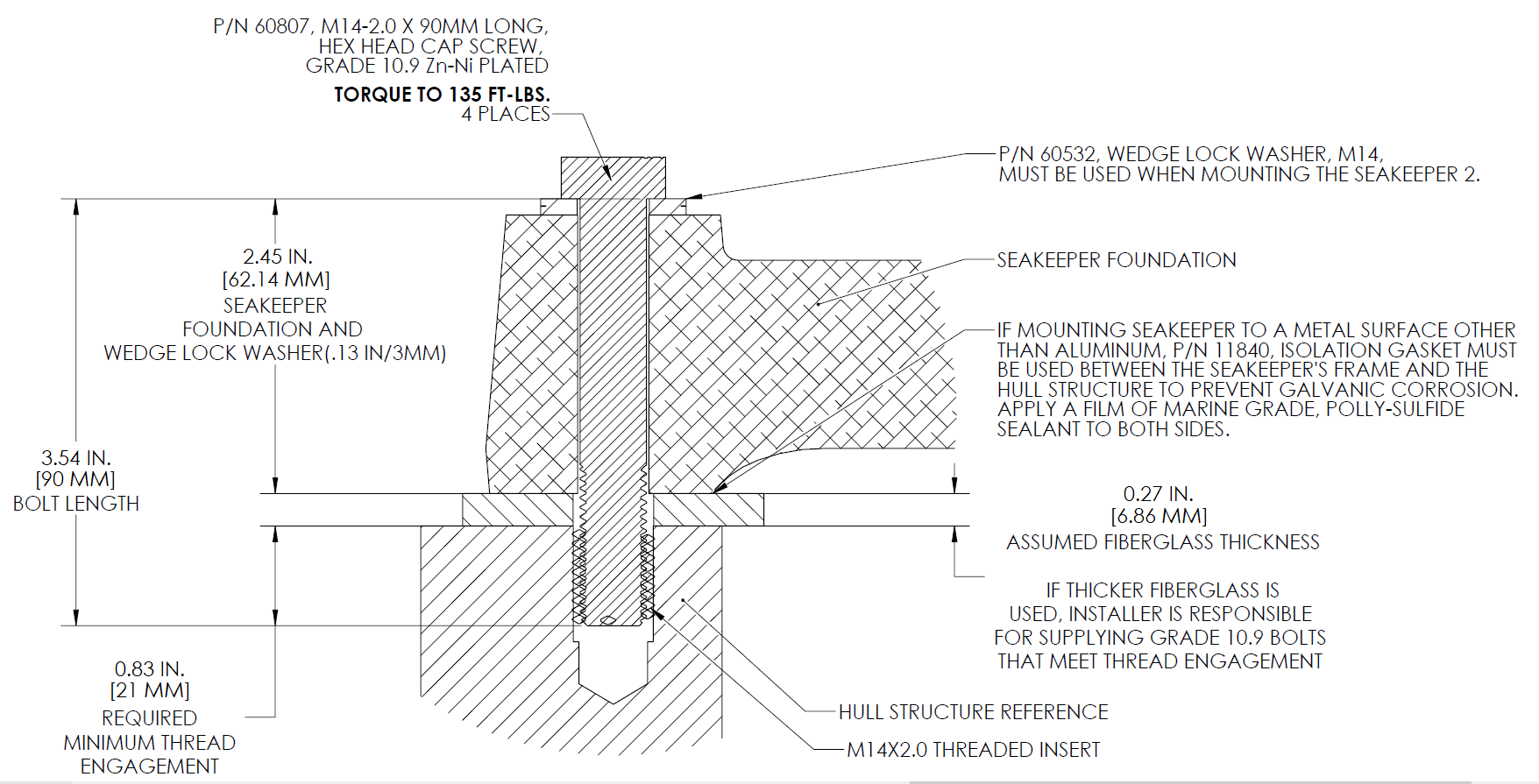

3.0 Electrical Installation
3.1 Electrical Installation Introduction
This section for electrical installation explains how to mount the electrical equipment and how to connect the electrical cables.
Reference Documents & Drawings:
- 90469 – Seakeeper 2 Hardware Scope of Supply
- 90470 – Seakeeper 2 Cable Block Diagram
- 90558 – ConnectBox Helm Mounting Kit
- TB-90191 Seawater Cooling Pump Recommendations
- TB-90575 – DC Installation Kits
- TB-90621 – Seakeeper Battery Sizing Recommendations
- TB-90640 – ConnectBox Connection Requirements
- Seakeeper MFD Compatibility Technical Bulletins
- Optional 5″ Touch Display
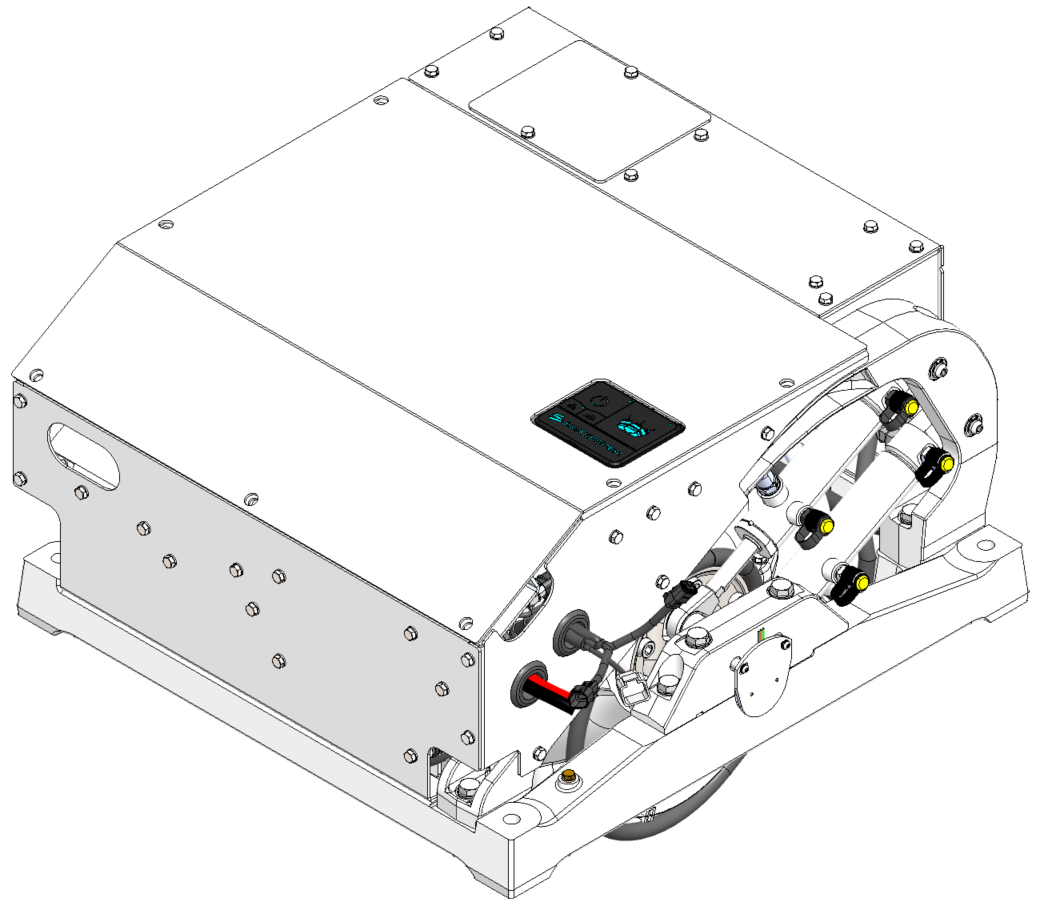
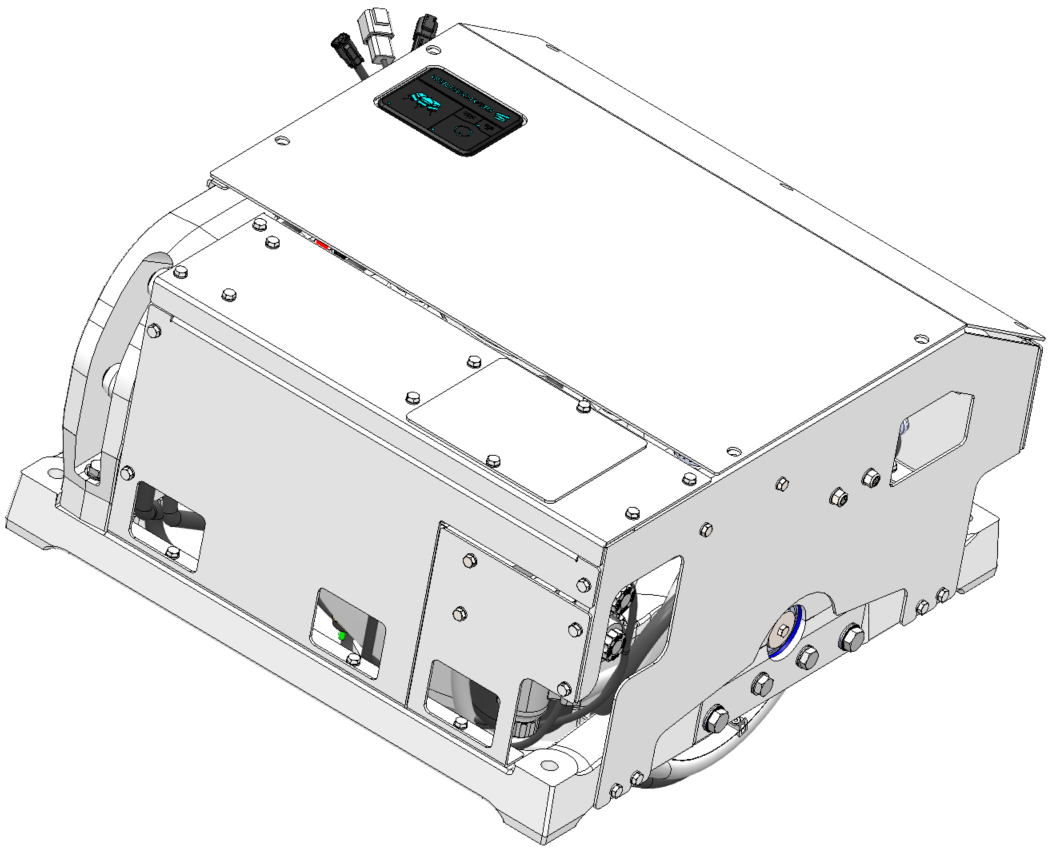


P/N 20248

Input Cable, P/N 30327
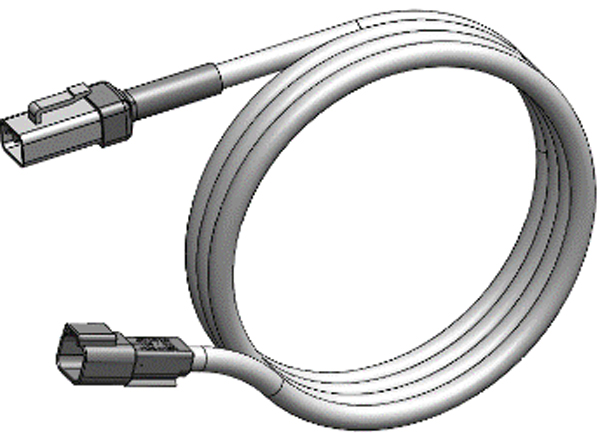
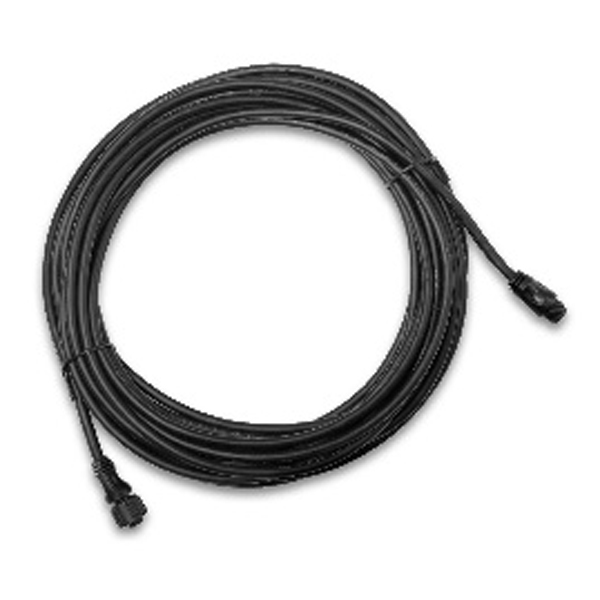

19.7 ft (6 m), P/N 30332
Figure 10 – Electrical Equipment for Seakeeper 2
3.2 Electrical Equipment Power Connections
3.2.1 High Current 12 V Power Input
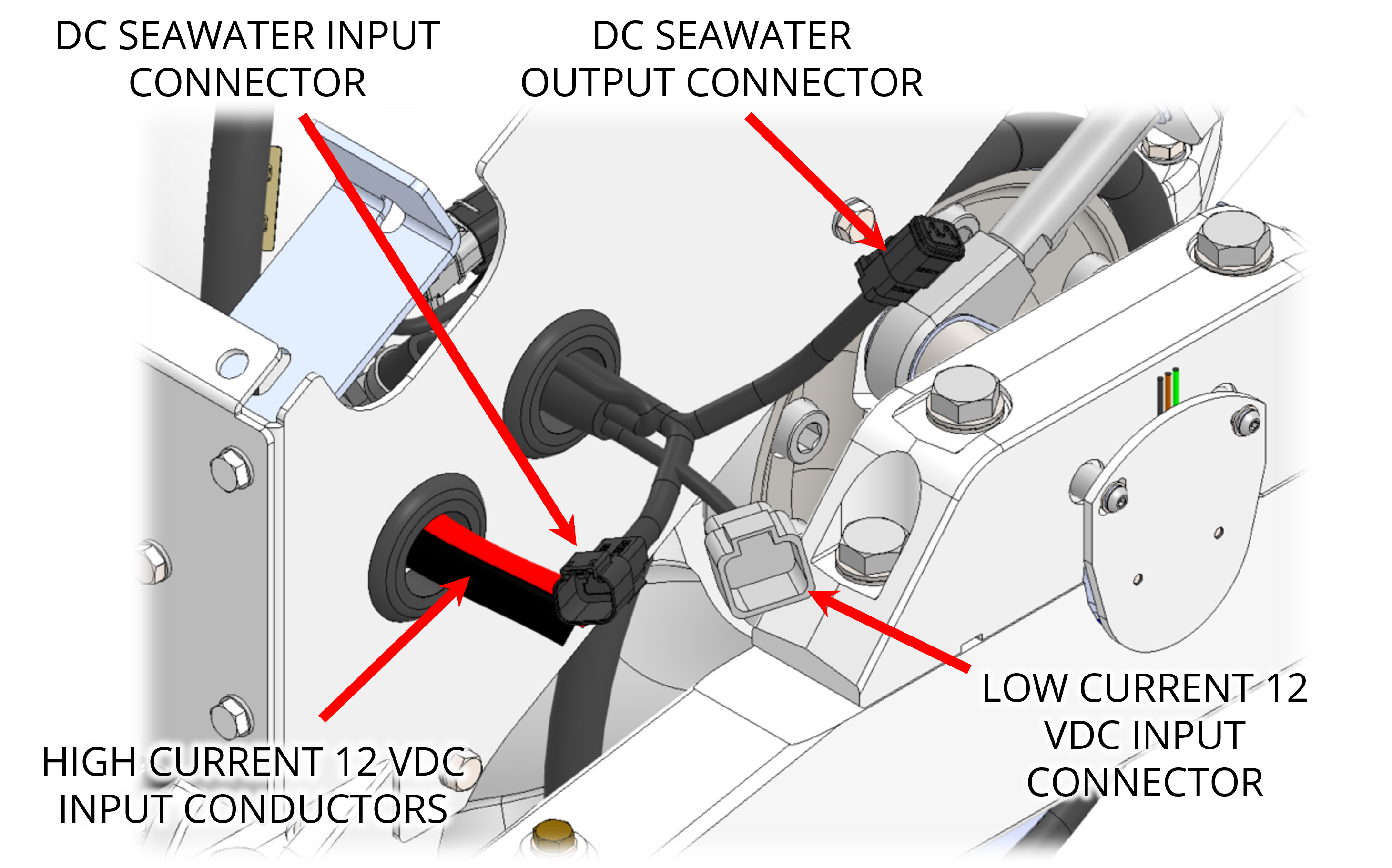
High Current 12 VDC Power Source Requirements
| Source | Battery Bank, 12 VDC, Marine, Deep Cycle (AGM battered recommended) |
| Voltage Range | 10 – 15 VDC |
| Continuous Current | 75 A |
| Overcurrent Protection | 100 A (Customer Supplied) |
High Current 12 VDC Power Connection Instructions
- High Current 2 AWG conductors connect the Seakeeper to the DC source are supplied as length 13ft (4 m). Approximately 3 ft (1 m) is routed inside the Seakeeper frame.
- If installing cables NOT provided by Seakeeper, ensure the folowing:
- Cable lengths do not exceed 29.5 ft (9 m)
- Cable gauge is 2 AWG or larger
- Cables bound together but not coiled
- When connecting aftermarket cables to the Seakeeper motor drive, observe the following:
- Ensure terminal stacks include flat washers, split-lock washers, and hex head screws that came with the Seakeeper.
- Torque battery terminal screws to 97 in-lbs (11 Nm).
- Verify lock washers seated flat and lugs cannot rotate (See Figure 12A).
- If installing cables NOT provided by Seakeeper, ensure the folowing:
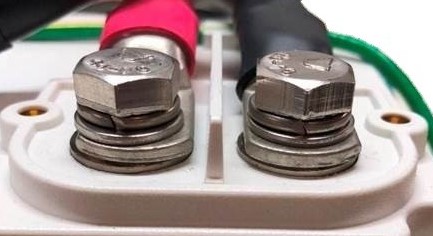
- Conductor length may be increased, but changing from 2 AWG to larger wire size does not allow longer length than 30 ft (9 m) each. The length limit is required to limit the inductance from the high current conductors.
- Use the shortest length and most direct route to the battery bank as possible.
- Bind positive (B+, red) & negative (B-, black) conductors together throughout entire length and do not coil.
- Connect positive conductor (B+, red) through dedicated over-current protection device (customer supplied) and a dedicated isolation switch (customer supplied) then directly to battery positive terminal.
- Connect negative conductor (B-, black) directly to battery negative terminal.
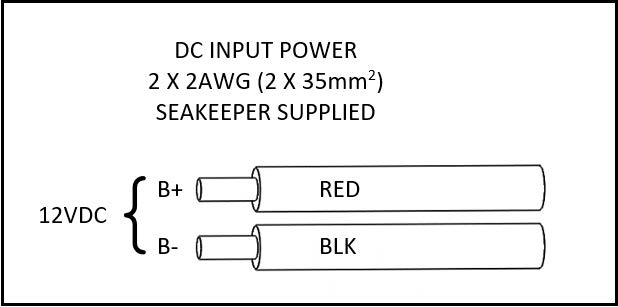
- If the 2 AWG high current 12 V power input conductors are shortened or lengthened, use heavy-duty eyelet (closed end) terminal such as Molex 19221-0235 and follow instructions on Seakeeper Drawing No. 90470 – Seakeeper 2 Cable Block Diagram, sheet 2.
- The bare wire strands should extend fully into the barrel of the heavy-duty eyelet and be crimped in two places if possible then sealed with double-wall heat shrink tubing. Crimp heavy-duty terminals with Quick Cable 4245 Crimp Tool, Molex 19284-0034 Crimp Tool, or equivalent using manufacturer’s instructions.

3.2.2 Low Current 12 V Power Input
Low Current 12 VDC Power Source Requirements
| Source | Battery Bank, 12 VDC, Marine, Deep Cycle |
| Alternate Source | Power Supply / Battery Charger, 12 VDC |
| Voltage Range | 11 – 15 VDC |
| Continuous Current | 9 A |
| Overcurrent Protection | 15 A (Customer Supplied) |
Low Current 12 VDC Power Connection Instructions
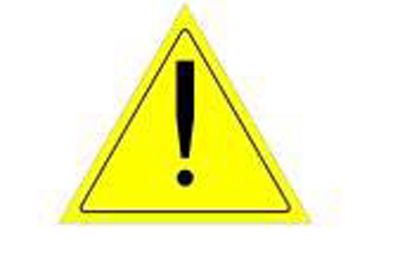
Reversing polarity on the DC power input to the Seakeeper can result in damaging the electronics in the control system.
- Install Seakeeper-provided Low Current DC Power Input Cable, (P/N 20248) to battery bank.
- Connect control power positive conductor (B+, red) through dedicated over-current protection device (customer supplied) and a dedicated Seakeeper isolation switch (customer supplied). A 2AWG, B+ conductor (red), is capable of carrying the current for both the High Current, Low Current, and Seawater Pump from the 12VDC power supply to the dedicated battery isolation switch.
- Connect negative conductor (B-, black) directly to battery minus terminal or negative DC bus bar.
- Before connecting Low Current Power Cable to Seakeeper, check for proper voltage and polarity with a DC multimeter using Figure 14 below.

When energizing DC power the first time, if display does not power up immediately then disconnect and inspect connector polarity.
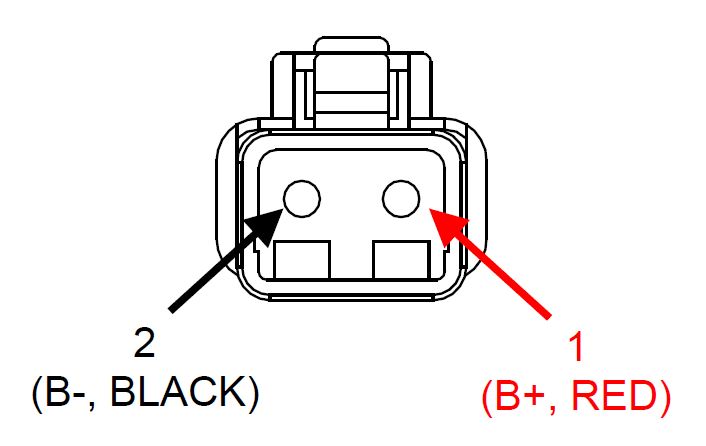
- Connect low-current control power cable to Low Current 12 VDC power input connector on the Seakeeper, Deutsch DTP04-2P connector.
3.2.3 DC Seawater Pump 12 V Power Output
DC Seawater Pump 12 VDC Power Source Specifications
| Source | 12 VDC from the Seakeeper |
| Voltage Range | 10 – 15 VDC |
| Continuous Current | On-demand, typically ~10 A |
| Overcurrent Protection | Per pump specification, max 15 A |
DC Seawater Pump 12 VDC Power Input Connection Instructions
- Located the Seawater Pump Power Input Cable (P/N 30327) for Seakeeper 2 “SW Pump DC In” connection on Seakeeper 2 wire harness (as shown in Drawing No. 90470).
- Connect the 16 AWG positive conductor (red) through dedicated overcurrent protection device (customer-supplied), maximum of 15A, to dedicated battery isolation switch.
- The High Current, 2AWG B+ conductor (red), is capable of carrying the current for both the High Current, Low Current, and Seawater Pump from the 12VDC power supply to the dedicated battery isolation switch.
- Connect the 16 AWG negative conductor (black) directly to battery negative terminal or DC main negative bus bar.
- Before connecting the SW Pump Power Input Cable to the Seakeeper 2, check for proper voltage and polarity with a DC multimeter using Figure 15 below.
- Connect SW Pump Power Input Cable to Seawater Pump 12 VDC In connector on the Seakeeper, DEUTSCH DT04-2P connector.

Seawater Pump 12 VDC Power Output Connection Instructions
- Locate the Seawater Pump Power Output Cable (P/N 20334) for “SW Pump 12VDC Out” connection on Seakeeper 2 wire harness (as shown in Drawing No. 90470).
- Pumps rated at 12 VDC, 15 amps maximum, customer-supplied, must be configured with a Deutsch DT series, 2-pin receptacle to mate with the connector as shown in Figure 16.
- TE Connectivity (Deutsch) DT04-2P Receptacle, 2-Way, for Male Pins (qty 1)
- TE Connectivity (Deutsch) 0460-202-1631 Pin, Solid, Gold-plated, Size 16, 16-20 AWG (qty 2)
- TE Connectivity (Deutsch) W2P Wedgelock for 2-Way DT Receptacle (qty 1)
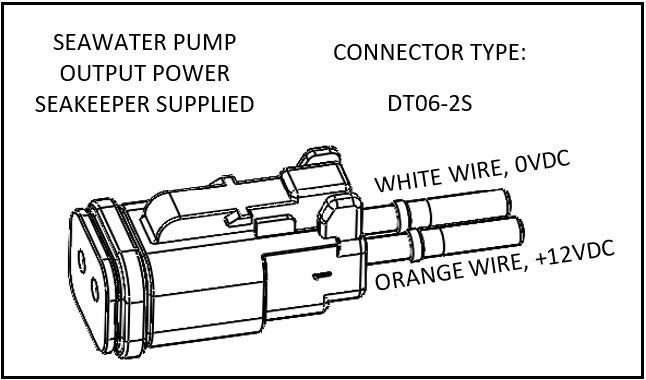
- The Seawater Pump Power Output Cable must be routed and installed in the vessel from the Seakeeper 2 “SW Pump 12VDC Out” Deutsch connector plug (pins end) to the DC seawater pump cable Deutsch connector (socket end).
- Connect Seawater Pump Power Output Cable (socket end) to the customer-supplied receptacle end (pins end). The recommended wiring arrangement is shown in Figure 17
- Seakeeper DC Seawater Pump Assembly (P/N 30331), which is prewired for the Seawater Pump Output Cable, is available as an option with the Seakeeper 2.

3.3 Electrical Equipment Ground Connections
Seakeeper to Vessel Ground Connection Instructions
- Connect the Seakeeper foundation ground stud, shown in Figure 18, to vessel ground.
- Install Ground Wire, 4 AWG (25 mm2), (Customer Supplied), from the M6 brass ground stud to vessel grounding bus to comply with:
- EM / IEC 60204-1 Clauses 6.3.3 and 8.2.3.
- ABYC E-11 July 2021 Clauses 11.5.2 and 11.17.
- Install Ground Wire, 4 AWG (25 mm2), (Customer Supplied), from the M6 brass ground stud to vessel grounding bus to comply with:
NOTE: ONLY USE THIS LOCATION FOR GROUNDING THE SEAKEEPER TO THE VESSEL GROUND.
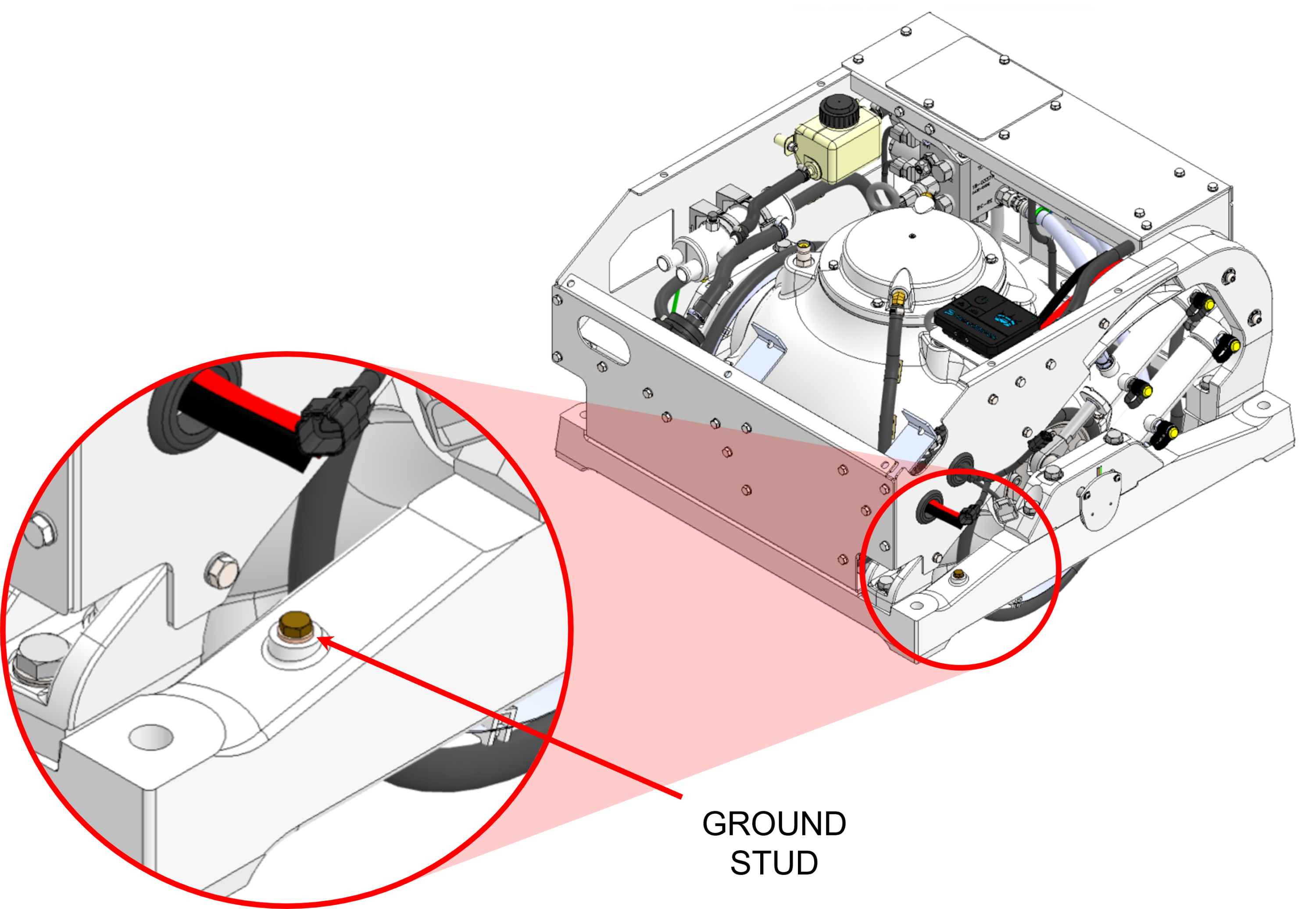
b. A proper ground connection is critically important for corrosion protection and helps to ensure the ignition protection of the unit by ensuring it does not carry any stray current.
c. NOTE: the ground is not referring specifically to a bonding system but for outboard boats generally refers to the outboard engine negative terminal, or its bus, to the DC grounding bus. This connection shall be used only as a means of maintaining the negative side of the circuit at ground potential and is not to carry current under normal operating conditions. See Figure 19.
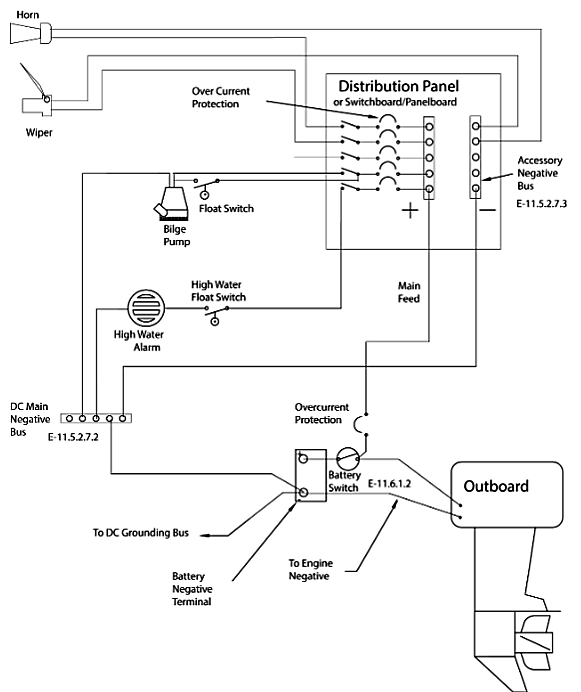
3.4 Display Connection
3.4.1 Seakeeper 2 Display Options
A Seakeeper display is required with the installation of a Seakeeper 2 to support the full functionality of the unit through the Seakeeper App in addition to the ConnectBox. The Seakeeper App provides an interface for controlling the Seakeeper 2 or viewing the Settings, Service, Info, and Alarm pages. The Seakeeper ConnectBox can be helm-mounted to provide an additional interface for the control of the Seakeeper 2 but does not replace the need for a Seakeeper compatible display.
The Seakeeper 2 has several options for establishing a Seakeeper display interface to support the Seakeeper App:
- Preferably, connect the Seakeeper 2 to a compatible Multifunction Display (MFD).
- Install an optional Seakeeper 5″ Touch Display.
- A combination of a compatible MFD and an optional 5″ Touch Display is also available, as seen in Figure 19 below (See drawing 90470).
Figure 20 provides a schematic of the display options. The subsequent sections outline the instructions and references for connecting the Seakeeper 2 to each of these display options.
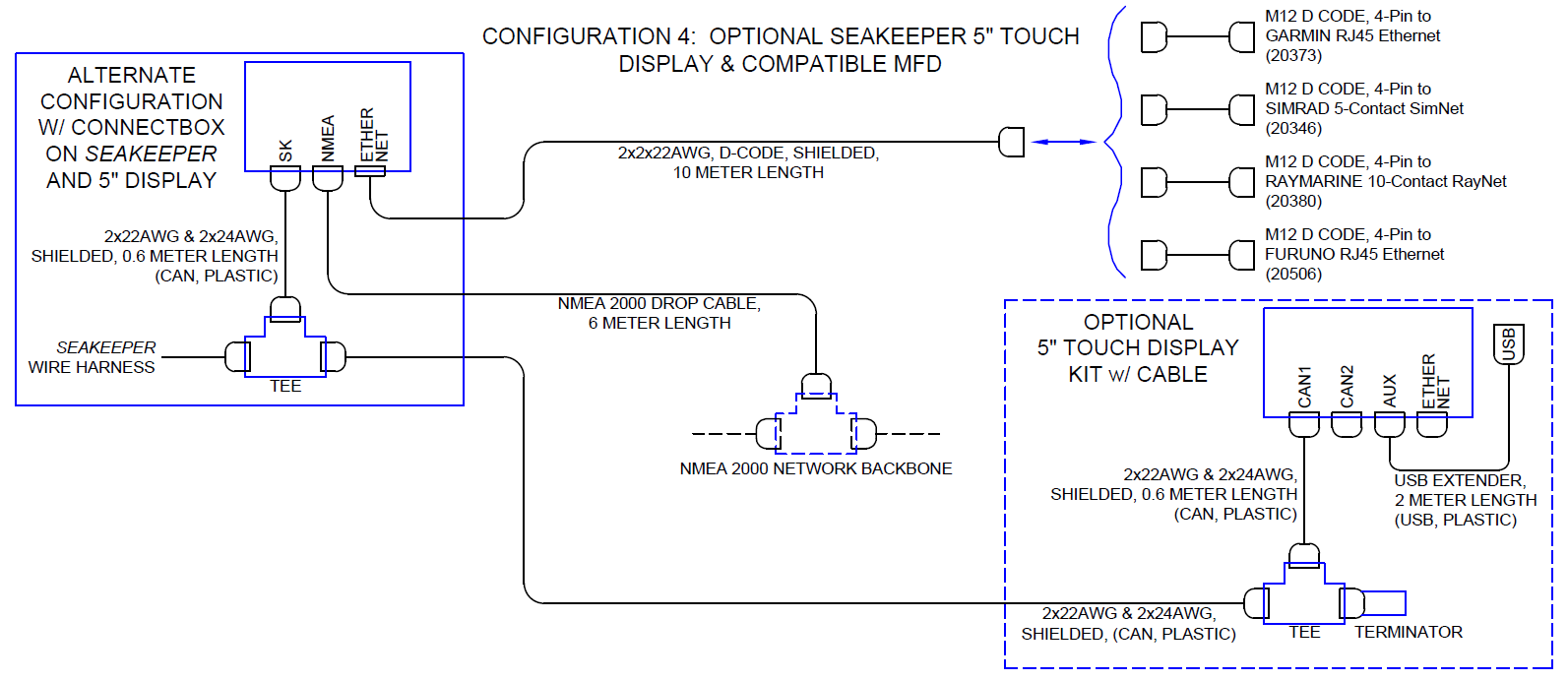
3.4.2 Connecting to Compatible MFD
- The Seakeeper 2 can be connected to a variety of available MFD systems. Refer to the Technical Bulletins Section of the Seakeeper Technical Library for manufacturer specific MFD compatibility technical bulletins.
- MFD specific Technical Bulletins will be updated regularly as new MFD systems become compatible. Currently Garmin, Raymarine, NAVICO, and Furuno offer compatible MFD models.
- Once a compatible MFD has been selected, refer to the appropriate manufacturer specific Technical Bulletin for integration instructions.
- Connect Seakeeper-supplied Ethernet Adapter, M12 D-Code, 32.8 ft (10 m), cable to MFD manufacturer-specific Ethernet adapter cable (See Figure 21). Custom Ethernet cables for specific MFD manufacturers are available through Seakeeper and must be purchased with the Seakeeper 2 if connecting to an MFD.

3.4.3 Connecting to an Optional Seakeeper 5″ Touch Display
If not utilizing a compatible MFD display, a Seakeeper 5” Touch Display must be purchased from Seakeeper. The Seakeeper 5” Touch Display (P/N 90467) includes the components shown in Figure 22 and will be integrated with the ConnectBox.
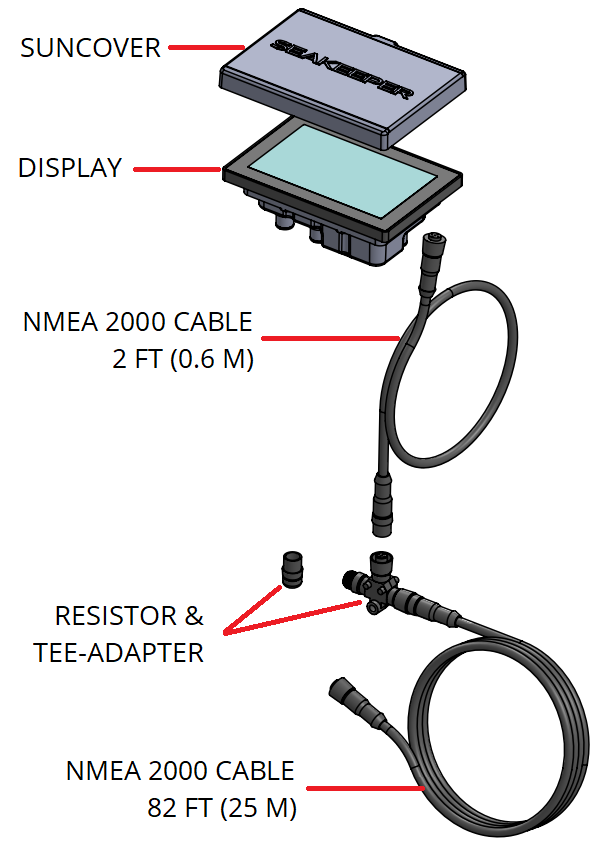
- Determine location of Seakeeper 5” Touch Display:
- The desired location of the 5” Touch Display must be determined with respect to the vessel’s arrangement.
- The 5” Touch Display should be located on or near the helm or another easily accessible location.
- Route CAN communications cable:
- The CAN Cable Assembly is a 32.8 ft (10 m) shielded cable that connects the ConnectBox to the 5” Touch Display.
- The CAN cable assembly must be routed and installed in the vessel from the Seakeeper wire harness CAN Tee to the Tee Adapter at the Seakeeper 5” Touch Display, included with P/N 90467.
- Install Seakeeper 5” Touch Display equipment:
- Console space required: Approx. 5.24 W x 3.70 H in. (133 x 94 mm)
- Mounting Instructions, Surface Mount: see Envelope and Mounting Details, in Drawing No. 90438 – 5” Operator Display Envelope and Mounting Details.
- CAN communications tee adapter and terminator mounting instructions:
- Console space required, Rear: Approx. 4 W x 3 H in. (102 x 76 mm), rear
- Mounting Instructions: Rear mount on vessel console panel, within 2 ft (0.6 m) of Display.
- Hardware required: One mounting screw for .197 in. (5 mm) diameter mounting hole on Tee Adapter.
- Connect Seakeeper 5” Touch Display Equipment:
- The Seakeeper 5” Touch Display is connected in accordance with Drawing No. 90470 – Seakeeper 2 Cable Block Diagram, as shown in Figure 23.

3.4.4 NMEA 2000 Network Connection
The Seakeeper 2 requires a connection to the vessel’s NMEA 2000 network backbone via a drop cable for access to the GPS signal. The Seakeeper 2 will monitor information on the NMEA network to support and optimize the performance of the Seakeeper 2. If no GPS signal is detected, a warning will appear on the Seakeeper display. The Seakeeper will not spool-down, but the operation of the unit will be limited until the GPS signal returns.
- Install customer-supplied NMEA 2000 Tee Adapter (space required: approximately 4 W X 3 H in. (102 X 76 mm).
- Connect NMEA Backbone to Tee Adapter. NOTE: NMEA drop cable can be no longer than 19.6 ft (6 m) in length.
- Connect Seakeeper-supplied NMEA cable (P/N: 30332) to the customer-supplied NMEA 2000 Tee Adapter on vessel’s NMEA 2000 backbone.
- An active NMEA 2000 compatible GPS signal is required on the vessel’s NMEA 2000 backbone to operate the Seakeeper 2.
- If no GPS signal is detected, a Speed Over Ground (SOG signal) warning will be present on the Seakeeper app. See TB-90640 for NMEA connectivity guidance.
- An active NMEA 2000 compatible GPS signal is required on the vessel’s NMEA 2000 backbone to operate the Seakeeper 2.
3.4.5 ConnectBox Helm Mounting – Optional
- Console space required: Approx. 3.41 L x 4.15 W in. (87 x 106 mm).
- Mounting Instructions, Surface Mount: See Drawing No. 90558 – ConnectBox Helm Mounting Kit, for details.
- Mount ConnectBox Replacement Blank insert into Seakeeper 2 enclosure at the original location of the ConnectBox.
4.0 Cooling Installation
4.1 Cooling Installation Introduction
Reference Documents & Drawings
- 90469 – Seakeeper 2 Hardware Scope of Supply
- 90490 – Seakeeper 2 Cooling Water Schematic
- 90470 – Seakeeper 2 Cable Block Diagram
The Seakeeper 2 is shipped with the cooling circuit filled and ready for use. The Seakeeper 2 requires connection to a raw water pump, referred to as the seawater pump, to cool the closed loop cooling circuit on the unit. The required seawater flow through the Seakeeper 2 heat exchanger is between 2 – 6 GPM (7.6 – 22.7 LPM) when the on-demand cooling system requires cooling. Prior to operation, confirmation of glycol level is recommended.
Seakeeper offers a compatible self-priming DC Seawater Pump (P/N 30331) prewired for the Seakeeper 2 Installation and covered under the standard Seakeeper warranty. The pump conforms to the seawater plumbing best practices noted in TB-90947. See Drawing No. 30331, SeaFlo® Seawater Pump Assembly, and the Seakeeper Options and Accessories Price List for details.

4.2 Installation Considerations
- The installer is responsible for supplying a dedicated positive-displacement seawater pump (or electric isolation valve and centrifugal pump) and associated plumbing. An optional seawater pump can be purchased through Seakeeper, P/N 30331.
- Unintended seawater flow from the seawater pick-up during the vessel’s underway operation is unacceptable and may cause stress to internal components. Unintended flow should be mitigated through pump selection, using a diaphragm-style pump or an inlet control valve. Continuous cooling flow from shared through-hull plumbing, a centralized chiller, or a cooling system is unacceptable for on-demand Seakeeper models.
- Seawater connections on the Seakeeper heat exchanger mate with ¾ in. (19 mm) hose.
- The Electrical Installation Section outlines that the seawater pump is powered via the “SW Pump 12 VDC Out” connection on the Seakeeper 2 wire harness.
- The seawater pump operates on 12 VDC with a max overcurrent protection rating of 15 A.
- A dedicated through-hull fitting should be installed for each Seakeeper to ensure sufficient seawater flow to that unit onboard the vessel.
- It is recommended that the seawater pump is located below the waterline, as close to the vessel’s baseline as practically possible, to maintain positive inlet pressure on the pump in all operating conditions.
- A self-priming seawater pump may be required to maintain water flow in all underway conditions. Cavitation can occur at the seawater inlet and potentially cause an air-lock condition restricting seawater flow to the heat exchanger.
- The maximum allowed seawater pressure in the heat exchanger is 20 psi (1.4 bar).
- The seawater flow requirement through the heat exchanger is 2 GPM (7.6 LPM) minimum and 6 GPM (22.7 LPM) maximum when on-demand cooling is required. When sizing the seawater pump, the installer should factor in losses for raw water plumbing. In addition to initial operation at the dock, new Seakeeper installations should be checked to be within the flow requirements while the vessel is at speed. Flows higher than 6 GPM (22.7 LPM) could affect the heat exchanger’s life.
4.3 Connecting Seawater to Heat Exchanger
Refer to Figure 25 for typical seawater plumbing arrangement.
- Connect seawater pump to Seakeeper dedicated through-hull fitting. A strainer and seacock valve should generally be installed between the seawater inlet and the pump.
- Connect seawater from the installer-supplied pump to the lower 3/4 in. (19 mm) hose barb on the heat exchanger. Use the same practices as for other below-waterline seawater plumbing.
- Connect seawater discharge to the overboard drain. Use the same practices as other seawater plumbing below the waterline.
- The required flow rate is 2 GPM (7.6 LPM) minimum and 6 GPM (22.7 LPM) maximum.
- In addition to initial operation at the dock, new Seakeeper installations should be checked for a minimum 2 GPM (7.6 LPM) flow while the vessel is at speed and when backing down.
- If no other method of confirming flow is available, the discharge line may be temporarily diverted to a bucket. Flow is calculated from time to fill a known volume.
- Flowrates in excess of 6 GPM (22.7 LPM) could affect heat exchanger life.
- Inspect raw water plumbing during sea trial for any signs of leakage.

4.4 Seakeeper Optional DC Seawater Pump
- Seakeeper offers a self-priming DC Seawater pump as an optional addition, P/N 30331 – DC Seawater Pump Assembly, shown in Figure 26.
- The Seakeeper Seawater Pump is a 24 VDC pump operated at 12 VDC for the Seakeeper 2 and maintains a seawater flow of approximately 2.5 GPM (9.5 LPM) at 12 VDC.
- The pump assembly is pre-wired for connection to the Seakeeper 2 and includes a seawater strainer and various fittings. The pump specifications are as follows:
NOTE: Use only SeaFlo®-provided threaded fittings for DC Seawater Pump 30331.
| Volts | 24 VDC (intended for 12 VDC operation with Seakeeper 2) |
| Flowrate | 2.5 GPM (9.5 LPM), at 12 VDC |
| Overcurrent Protection Rating | 15 A |
| Ignition Protection Rating | ISO 8846 or equivalent |
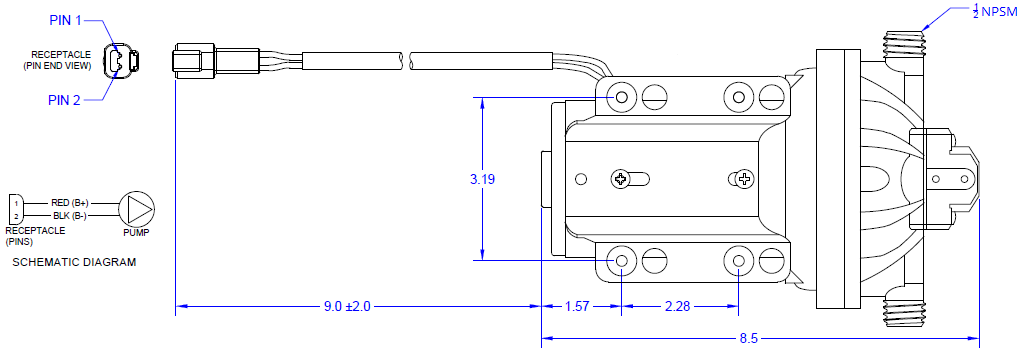
4.5 Adding Coolant
- The Seakeeper 2 cooling system is filled to proper level when shipped. If level has dropped, check for evidence of leaks at all connections before adding fluid as described below. If coolant is at the correct level, skip to Step 5.
- The minimum and maximum glycol fill levels are shown in Figure 27.

- Mix 50% ethylene glycol with 50% distilled water in a clean container. Refer to Table 1 or glycol manufacturer’s literature for freezing points.
- It is required that ethylene glycol with corrosion inhibitors be used. Most commercially available glycol has these additives standard.

- Remove reservoir cap and pour mixture in until level reaches top face of the reservoir enclosure, as shown in Figure 27.
- Filling reservoir above this level will not cause any damage but coolant may be expelled from the vented cap due to normal thermal expansion of coolant.
- Once the Seakeeper 2 and DC seawater pump are connected to 12 VDC power:
- Check the Seakeeper Display interface for any ALARMS.
- Cycle the Seakeeper 2 power, and press the POWER ON button.
- The flywheel will start to spin, and the glycol pump will start.
- Recheck glycol level with fluid circulating in coolant circuit to ensure the correct fill level is maintained.
- After several minutes of running, press POWER OFF button.
- The cooling system is self-purging. If small amounts of air are in the system, they should be dislodged during the first sea trial. Recheck level after sea trial and add fluid if required.
NOTE: It is not uncommon to see some air in the coolant system. It is normal and will not affect operation.
5.0 Installation Requirements
6.0 Installation and Start Up Checklist
6.1 Installation and Start Up Introduction
Reference Documents:
The Installation and Start Up Checklists in this section provide an overview of the primary steps covered in the installation manual and should be referenced throughout the installation process. Upon completion of the
Seakeeper 2 installation, the installer should commission each Seakeeper unit with the Seakeeper Commissioning Form (90437). The Commissioning Checklist Work Instruction (SWI-105) provides a checklist of items to inspect and verify during the commissioning process and serves as a supplement to the Seakeeper Commissioning Form (90437).
All Seakeeper stabilizers should be commissioned to verify installation specifications and requirements have been implemented properly. The commissioning process should include completion of the Seakeeper
Commissioning Form (90437), all the items in the Installation Checklist, and verification of Seakeeper 2 operation without alarms or abnormal behavior.
6.2 Installation Checklist
Mechanical Checklist
(Reference Section: 2.0 Mechanical Installation)
- Seakeeper foundation installed per requirements of the Seakeeper 2 Bolt-In Installation Details.
- Clearances around Seakeeper meet service and operating specifications and no obstructions are within the Seakeeper envelope
- Seakeeper supplied foundation bolts torqued to specification
Electrical Checklist
(Reference Seakeeper Drawing No. 90470 – Seakeeper 2 Cable Block Diagram & Section: 3.0 Electrical Installation)
Mount Components
- Display (near helm)
Connect Seakeeper and Customer Supplied Cables
- High Current 12 VDC Conductors (Seakeeper Supplied)
- Connect High Current DC Input cables (P/N: 20335 and 20336) to customer supplied 2 AWG B+ and B- conductors to allow for routing to 12 VDC power source.
- Connect High Current DC Input B+ conductor (red) through 100 A circuit breaker(customer-supplied) and a dedicated battery isolation switch (customer-supplied), directly to the battery positive terminal or bus bar.
- Connect High Current Input B- conductor (black) to battery negative terminal or DC negative bus bar.
NOTE: If the 2 AWG high-current 12V power input conductors are shortened or lengthened, use heavy-duty eyelet (closed end) terminals such as Molex19221-0235.
- Ground Cable (Customer Supplied)
- Install lugs on both ends of customer-supplied 4 AWG ground cable.
- Connect one end of Ground Cable to nearest vessel ground and other end to Seakeeper foundation.
- Vessel grounding bus to comply with:
* EM/IEC 60204-1 Clauses 6.3.3 and 8.2.3
* ABYC E-11 July 2018 Clauses 11.5.2 and 11.16.1.
- Low Current 12 VDC Power Input Cable (Seakeeper Supplied)
- Connect DC Input positive (red) cable (P/N: 20248) directly to a customer-supplied 15 A circuit breaker, then to the dedicated battery isolation switch
- Connect DC Input negative (black) cable (P/N: 20248) to the DC negative bus bar or battery negative terminal.
- Plug DC Input Cable connector end into the DT-Series connector labelled Low-Current 12 VDC in connector on the Seakeeper wire harness.
- DC Seawater Pump Input Cable (Seakeeper Supplied)
- Connect Seawater Pump Input positive (red) cable (P/N: 30327) directly to a customer-supplied circuit breaker corresponding to the seawater pump overcurrent protection rating (max 15 A), then to the dedicated battery isolation switch.
- Connect Seawater Pump Input negative (black) cable (P/N: 30327) to the DC main negative bus bar or battery negative terminal.
- DC Seawater Pump Output Cable (Seakeeper Supplied)
- Connect female end of DC Seawater Pump Output Cable (P/N 20334) to customer supplied 12 VDC, 15 A seawater pump.
- Plug male end connector of DC Seawater Pump Output Cable (P/N 20334) into mating connector on the Seakeeper wire harness
Cooling Checklist
(Reference Installation Manual Section: Cooling Installation)
- Connect seawater hoses / open sea cocks to heat exchanger and test seawater pump.
- Verify 2 GPM (7.6 LPM) minimum and 6 GPM (22.7 LPM) maximum seawater flow through heat exchanger under all operating conditions of the boat. (The seawater pump output will operate for two minutes after the Seakeeper is turned on. During operation, the seawater pump output is turned on and off based on the temperature of the Seakeeper)
- Verify coolant level in heat exchanger coolant reservoir.
Start Up Checklist
(Reference Installation Manual Section: Start Up & Operation Manual Section: System Operation)
- Remove lifting bolts and install cover panels
- Turn on 12 VDC 15 A circuit breaker
- Turn on 12 VDC 100 A circuit breaker
- Verify display works and no ALARMS are present
- If display does not work, turn off both circuit breakers immediately
- Check polarity of 12 VDC 15 A power per Section 2.2.5
- Follow instructions in Installation Manual Section: Start Up Instructions, to turn on the Seakeeper
- Verify seawater pump turns on when the Seakeeper is turned ON
- Verify that no ALARMS are present
- Follow instructions in Installation Manual Section: Start Up Instructions, to turn off the Seakeeper
- DC power and seawater pump may be turned off after the Seakeeper is turned off by placing the Seakeeper in LOCK mode and turning the Seakeeper off
- Seakeeper 2 takes 16+ hours to coast down to 0 RPM from full speed
6.3 Start Up Checklist
Refer to Seakeeper 2 Operation Manual, Start Up Section for detailed start up instructions.

Prior to beginning the start-up sequence all previous Sections of the Installation Manual for Mechanical, Electrical, and Cooling installation must be complete. Before continuing, the Seakeeper 3 cover must be installed, and the operating clearances must be clear of personnel and equipment
| CHECK | REQUIREMENT TO BE MET |
| Remove lifting eyebolts and install sealing bolts (M10-1.25 X 12 mm) and flat washers into lifting eyeholes and install cover. | |
| Energize battery isolation switch, high-current 100 A breaker, low-current 15 A breaker, and seawater pump breaker. | |
| Verify Seakeeper display is active and no alarms present. * If the Seakeeper 3 display does not activate, turn off all circuit breakers immediately and check all wiring connections. | |
| Check that battery voltage exceeds 12 VDC. A minimum battery voltage of 11 VDC is required for the duration of Seakeeper spool-up. | |
| Override seawater pump “ON” and verify flow at seawater outlet. (To activate override, at 0 RPM flywheel speed, hold down SERVICE button wrench icon for 5 seconds to reveal override screen) | |
| Deactivate seawater pump when completed obtaining seawater flow rate. | |
| Press Seakeeper ON/OFF Button and follow instructions in Seakeeper 2 Operation Manual for complete start-up instructions. | |
| Verify no alarms are present. | |
| Power Seakeeper 2 down, the Seakeeper 2 flywheel will take 2+ hours to coast down to 0 RPM. |
5.1 Installation Requirements Introduction
The Installation Requirements section outlines the components and tools needed for the Seakeeper 2 Installation that are not included within the scope of supply. Seakeeper offers Core Installation Kits which provide the required components for DC Seakeeper installations. These kits are outline in the DC Installation Kits Technical Bulletin (TB-90575).
5.2 Supplies Required for Installation
(Not Supplied With the Seakeeper)
| Item | Description | Qty | Installation Manual Reference Section | Other Reference | System |
|---|---|---|---|---|---|
| 1 | Soundproofing Considerations | Selection of Installation Location | Mechanical | ||
| 2 | Spreader bar for lifting the Seakeeper | 1 | Transport and Unpacking | Mechanical | |
| 3 | Seakeeper 2 Fixture Kit | 1 | Bolt-In Installation | P/N 90473 | Mechanical |
| 4 | Hose clamps for seawater plumbing to ¾ in. (19 mm) hose barb (2 per hose barb) | 4 | Connecting Seawater to Heat Exchanger | Dwg 90490 | Cooling |
| 5 | 3/4 in. (19 mm) ID Hose | AR | Connecting Seawater to Heat Exchanger | Dwg 90490 | Cooling |
| 6 | Seacock Valve | 1 | Connecting Seawater to Heat Exchanger | Dwg 90490 | Cooling |
| 7 | Seawater Strainer (included with Seakeeper Seawater Pump (P/N 30331)) | 1 | Connecting Seawater to Heat Exchanger | Dwg 90490 | Cooling |
| 8 | Through-Hull Fittings (1 high speed pick up and 1 overboard discharge) | 2 | Connecting Seawater to Heat Exchanger | Dwg 90490 | Cooling |
| 9 | M6 terminal lug for grounding Seakeeper at rear brace | 1 | Electrical Equipment Ground Connections | Dwg 90470 | Electrical |
| 10 | Cable, 4 AWG, for grounding Seakeeper at foundation to vessel ground (used with item 5) | AR | Electrical Equipment Ground Connections | Dwg 90470 | Electrical |
| 11 | Seawater pump, 12 VDC, 15A max | 1 | Electrical Equipment DC Pump Power | Dwg 90470 | Electrical |
| 12 | 100 A Circuit breaker for Conductor 1 | 1 | Electrical Equipment High Current Power Input | Dwg 90470 | Electrical |
| 13 | 15 A Circuit breaker for Low Current Power and DC Seawater Pump | 2 | Electrical Equipment Low Current Power Input | Dwg 90470 | Electrical |
| 14 | Battery Isolator Switch | 1 | Electrical Equipment Power Connections | Dwg 90470 | Electrical |
| 15 | Marine Sealant | AR | Bolt-In Installation | DWG 90487 | Mechanical |
| 16 | Nickel-based Anti-Seize | AR | Bolt-In Installation | DWG 90487 | Mechanical |
AR = As Required
Dwg = Drawing
7.0 Revision History
| Revision | Description | Date |
| 2 | Mounting screw torque change | 01JUN2018 |
| 3 | Seawater cooling modifications | 07AUG202 |
| 4 | ConnectBox release changes added. New bolt-in installation kit and details added. Added crate stacking recommendations. | 21JUL2023 |
| 4.1 | Added DC motor power supply cable restrictions on cables not supplied by Seakeeper. | 09AUG2024 |
5.3 Tools Required for Installation
List of Common Tools That May Be Required for Installation
| Item | Description | Use |
| 1 | Hoist, Forklift, or Crane | Unpacking and lifting Seakeeper 3 into position |
| 2 | Transfer Punch Kit | Locate foundation hole penetrations |
| 3 | Drill / Drill Press | Bolt hole penetrations |
| 4 | Threaded Insert Installation Kit | Tap and install threaded inserts (M14-2 X 1.5) |
| 5 | Flexible Extendable Magnet, McMaster P/N: 3838A42 or similar | Lowering foundation bolts into place |
| 6 | 1/2″ Drive Torque Wrench | Foundation Bolts (155 ft-lbs/210 Nm) |
| 7 | 12 – 18″ Extension, 1/2″ Drive | Foundation Bolts |
| 8 | 24mm Socket, 1/2″ Drive | Foundation Bolts |
| 9 | Utility Knife | Scoring Cable Jackets |
| 10 | Wire cutter | DC Power cables |
| 11 | Wire stripper | DC Power cables |
| 12 | Greenlee K05-Synchro Crimp Tool or equivalent | 12 VDC High-Current Input Cables, 2AWG Ground Cable, 4 AWG |
| 13 | Heat Gun | For cables 1, 2, and 6 heat shrink |
| 14 | ¼ in. (7mm) Nut Driver / Flat Head Screwdriver | Hose clamps |
| 15 | Fish Tape | Cable Pulls |
| 16 | Hole Saw | Thru-hull fittings |